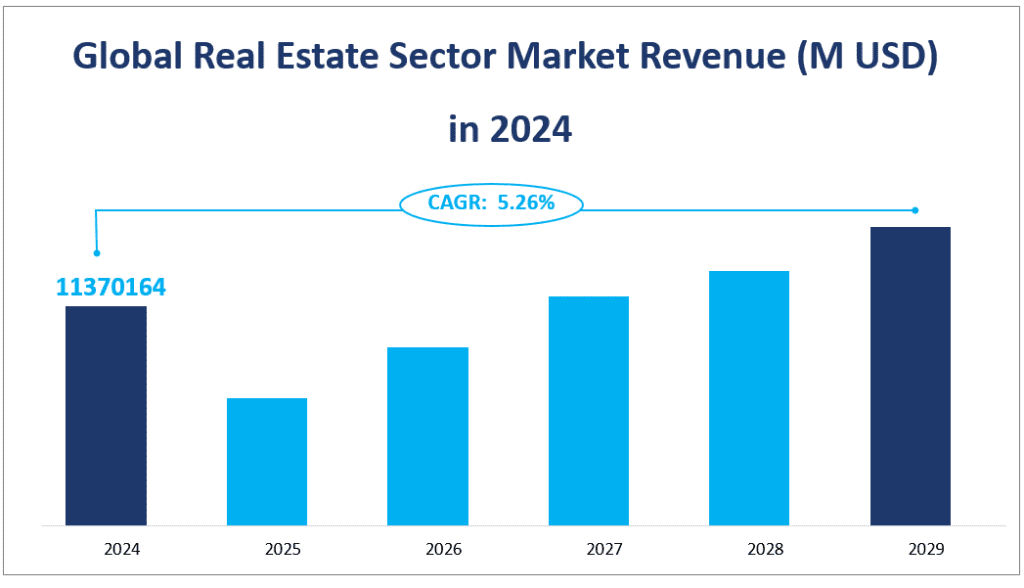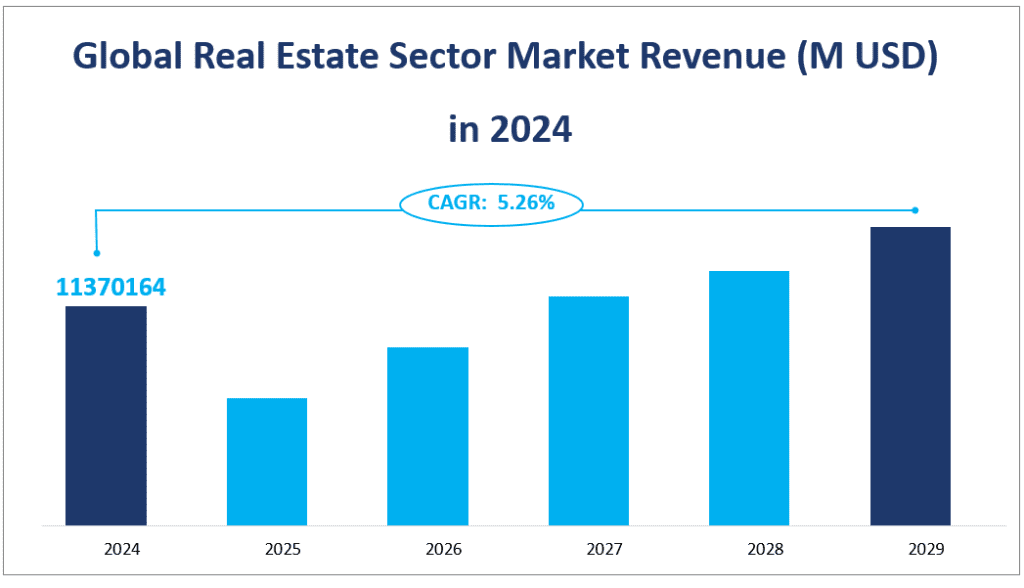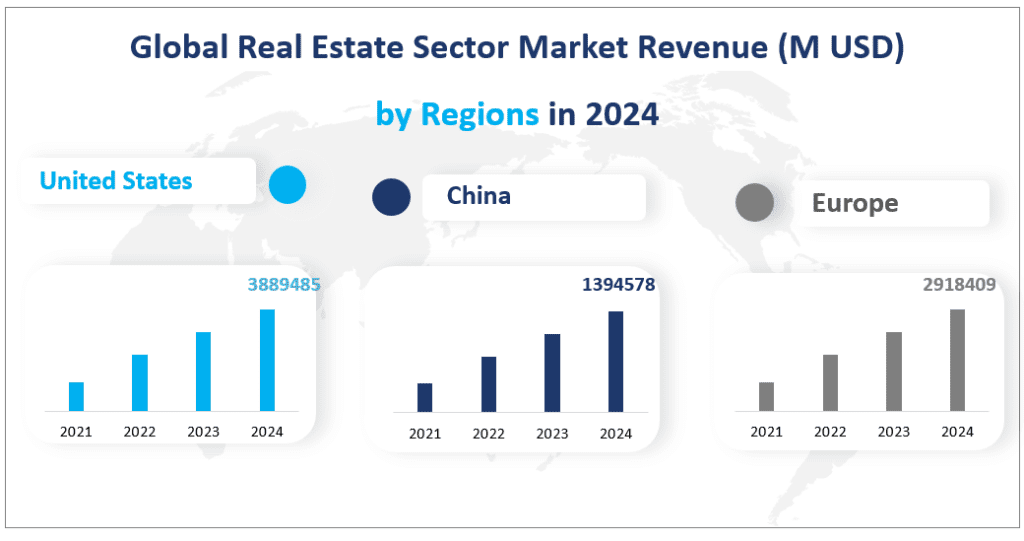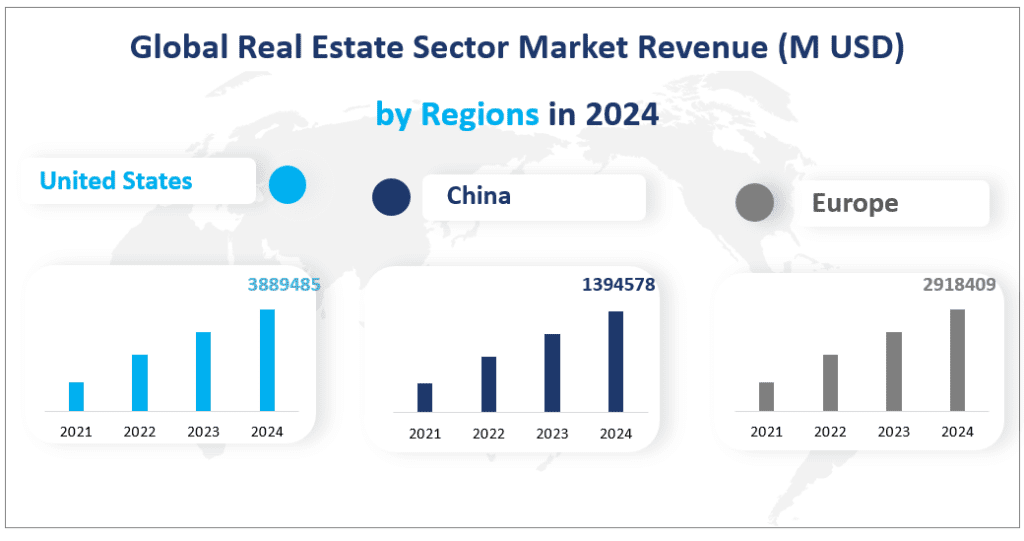1. Global Real Estate Market Definition
The global real estate market is a dynamic and multifaceted sector that plays a pivotal role in the world economy. In 2024, the real estate market is projected to generate a substantial revenue of $11370164 million with a CAGR of 5.26% from 2024 to 2029.
Real estate, by definition, encompasses a broad range of activities related to the development, management, and sale of properties. This includes residential, commercial, and industrial properties, as well as land. The sector is not just about bricks and mortar; it is a complex ecosystem that involves financial transactions, legal processes, and the integration of various services such as property management, maintenance, and brokerage. The real estate market is also intrinsically linked to the broader economic landscape, influenced by factors such as interest rates, employment levels, and consumer confidence.
Global Real Estate Market Revenue (M USD) in 2024


2. Driving Factors of Real Estate Market
The growth of the global real estate market is driven by several key factors. Firstly, the increasing global population and urbanization trends are creating a continuous demand for housing and commercial spaces. As more people move to cities in search of better opportunities, the need for residential and commercial real estate grows. Secondly, technological advancements are transforming the way real estate is bought, sold, and managed. The rise of online platforms and digital tools has made the process more efficient and accessible, attracting a wider range of investors and buyers.
Additionally, government policies and investments in infrastructure are also playing a crucial role in stimulating real estate market growth. For example, government-funded construction projects can boost the demand for real estate in certain areas, leading to increased property values and development opportunities.
3. Limiting Factors of Real Estate Market
However, the real estate market also faces several limiting factors that can impede its growth. One of the most significant challenges is the economic instability and fluctuations in the global economy. Recessions, changes in interest rates, and inflation can all impact the affordability and attractiveness of real estate investments. High levels of debt, both public and private, can also put pressure on the real estate market, as it can lead to increased costs and reduced investment opportunities.
Furthermore, regulatory changes and zoning laws can restrict the development of new properties, limiting the supply and potentially driving up prices. Environmental concerns and the need for sustainable development are also becoming more prominent, requiring the industry to adapt to new standards and practices.
4. Global Real Estate Market Segment
Product Types of Real Estate Market
The global real estate market is a vast and diverse sector, comprising various product types and applications, each with its own unique characteristics and market dynamics.
The real estate market can be broadly categorized into two main product types: the renting market and the retail market. The retail market, which includes the development and sales of properties, as well as second-hand buying and selling, holds the largest market share with revenue of $8244409 million in 2024. This is due to the continuous demand for new and existing properties for residential and commercial purposes. The retail market’s vastness and the high volume of transactions contribute to its significant share of the overall real estate market revenue.
In terms of growth rate, the renting market is anticipated to have a faster growth rate compared to the retail market with revenue of $3125754 million in 2024. This growth can be attributed to the increasing preference for rental properties, especially in urban areas where property ownership may not be feasible for everyone. The rise in rental demand is also driven by the flexibility it offers to tenants, allowing them to adapt to changing living and working conditions without the long-term commitment of property ownership.
Applications and Their Market Revenue in 2024
The applications of the real estate market are diverse, ranging from commercial real estate to residential real estate, which can be further divided into multifamily and separate house categories. In 2024, the market revenue for commercial real estate is expected to be $4859115 million, multifamily residential real estate is projected to generate $2274173 million, and separate house residential real estate is anticipated to have a revenue of $4236875 million.
Commercial real estate, which includes office buildings, hotels, shopping malls, and other similar properties, holds the largest market share. This is due to the essential role these properties play in the functioning of businesses and the economy. The high demand for office spaces and retail outlets, especially in urban centers, contributes to the significant revenue generated by this application.
In terms of growth rate, multifamily residential real estate market is expected to have the fastest growth. The growth in multifamily residential real estate can be attributed to the increasing urban population and the need for affordable housing options. As more people move to cities, the demand for apartments and other multifamily housing units rises, driving up the market revenue for this application.
The global real estate market in 2024 presents a complex picture with different product types and applications contributing to its overall revenue. The retail market, with its broad scope and high transaction volume, holds the largest market share, while the renting market shows a promising growth rate. In terms of applications, commercial real estate dominates the market revenue, but multifamily residential real estate is the fastest-growing segment.
Market Revenue and Share by Segment
| Market Revenue (M USD) in 2024 | Market Share in 2024 | ||
| By Type | Renting Market | 3125754 | 27.49% |
| Retail Market | 8244409 | 72.51% | |
| By Application | Commercial Real Estate | 4859115 | 42.74% |
| Multifamily of Residential Real Estate | 2274173 | 20.00% | |
| Separate House of Residential Real Estate | 4236875 | 37.26% |
5. Regional Real Estate Market in 2024
The United States stands out as the largest regional real estate market with revenue of $3889485 million in 2024, with a substantial share of the global real estate sector. This is attributed to its robust economy, technological advancements, and a well-established infrastructure that supports the real estate industry.
Following the United States, Europe is another significant player in the global real estate market with revenue of $2918409 million in 2024. With a rich history of economic development and a dense network of urban centers, Europe’s real estate market is known for its stability and sophistication. The region’s real estate market revenue in 2024 is expected to be substantial, driven by factors such as urban regeneration projects, the growth of the service sector, and the increasing demand for sustainable and smart city developments.
China’s real estate sector is rapidly emerging as a key real estate market with significant growth potential. The country’s rapid urbanization, economic expansion, and government policies supporting infrastructure development have propelled the real estate market to new heights. In 2024, China is expected to see a considerable increase with market revenue of $1394578 million in 2024.
Latin America’s real estate market is influenced by a variety of factors, including economic stability, political climate, and social development. In 2024, the region is expected to show signs of recovery and growth with revenue of $340093 million in 2024, particularly in countries with stable economies and a focus on infrastructure development.
The Middle East and Africa region presents a diverse real estate market, with some countries experiencing rapid growth due to economic diversification and investment in infrastructure. In 2024, the region is expected to see varying levels of market revenue with $326510 million, with the Gulf states leading the way due to their economic strength and focus on sustainable development.
Global Real Estate Sector Market Revenue (M USD) by Regions in 2024


6. Analysis of the Top 3 Companies in the Global Real Estate Sector
Country Garden, established in 1992, is one of the largest urbanized residential developers in China. The company operates through a centralized and standardized operation mode, providing diversified products to meet different market needs.
Country Garden offers a wide range of residential properties, from single-family homes to multi-family residential complexes. The company is known for its commitment to quality and innovation, integrating smart home technology and sustainable practices into its developments. Additionally, Country Garden provides property management services, ensuring a high standard of living for its residents.
Greenland Holdings, founded in 1992, is a leading integrated real estate market company in China. The company is engaged in the development, sales, and leasing of real estate properties. It also provides second-hand housing intermediary services, financial services, industrial park leasing, commercial and hotel operations, subway investment industries, and entrusted construction management services. Greenland Holdings has a global presence, with sales regions mainly in Asia-Pacific, Europe, and North America.
Greenland Holdings offers a variety of functional product categories, including super high-rises, international convention and exhibition centers, and modern industrial parks. The company is known for its large-scale development projects and its ability to create integrated communities that cater to both residential and commercial needs.
Vanke, established in 1984, is a prominent player in the real estate market, with its main business focusing on property development and sales. The company operates through the Property Development and Property Management divisions. Vanke is known for its commitment to quality and innovation, developing residential properties that meet the needs of modern consumers. The company’s operations span across Asia, North America, and Europe, reflecting its global aspirations and market reach.
Vanke offers a range of residential properties, including single-family homes, multi-family residential complexes, and long-term rental apartments under its brand “Port Apartment.” The company is also involved in the development of commercial properties and provides property management services to ensure the well-being of its residents and tenants.
Major Players
| Company Name | Sales Region |
| Country Garden | Mainly in Asia |
| Greenland Holdings | Mainly in APAC, Europe, North America |
| Vanke | Mainly in Asia, North America, Europe |
| Brookfield Asset Management | Worldwide |
| Lennar | Mainly in USA |
| D.R. Horton | Mainly in USA |
| JLL | Worldwide |
| PulteGroup | Mainly in USA |
| Mitsubishi Estate | Mainly in Asia |
| Greystar | Mainly in Americas, Europe, APAC |
| Prologis | Mainly in Americas, Asia, Europe |
| Vonovia | Mainly in Europe |
1 Real Estate Sector Market Overview
1.1 Product Overview and Scope of Real Estate Sector
1.2 Real Estate Sector Market Segment by Type
1.2.1 Global Real Estate Sector Market Revenue and CAGR (%) Comparison by Type (2021-2028)
1.2.2 Different Type of Real Estate Sector
1.3 Global Real Estate Sector Market Segment by Application
1.3.1 Real Estate Sector Market Consumption (Value) Comparison by Application (2021-2028)
1.3.2 Different Application of Real Estate Sector
1.4 Global Real Estate Sector Market, Region Wise (2017-2028)
1.4.1 Global Real Estate Sector Market Size (Value) and CAGR (%) Comparison by Region (2017-2028)
1.4.2 United States Real Estate Sector Market Status and Prospect (2017-2028)
1.4.3 Europe Real Estate Sector Market Status and Prospect (2017-2028)
1.4.4 China Real Estate Sector Market Status and Prospect (2017-2028)
1.4.5 Japan Real Estate Sector Market Status and Prospect (2017-2028)
1.4.6 India Real Estate Sector Market Status and Prospect (2017-2028)
1.4.7 Southeast Asia Real Estate Sector Market Status and Prospect (2017-2028)
1.4.8 Latin America Real Estate Sector Market Status and Prospect (2017-2028)
1.4.9 Middle East and Africa Real Estate Sector Market Status and Prospect (2017-2028)
1.4.10 Australia Real Estate Sector Market Status and Prospect (2017-2028)
1.5 Global Market Size of Real Estate Sector (2017-2028)
1.6 Global Macroeconomic Analysis
1.7 The impact of the Russia-Ukraine war on the Real Estate Sector Market
2 Industry Outlook
2.1 Real Estate Sector Industry Technology Status and Trends
2.2 Industry Entry Barriers
2.2.1 Analysis of Financial Barriers
2.2.2 Analysis of Experience Barriers
2.2.3 Analysis of Talent Barriers
2.2.4 Analysis of Sales and Service Network Barriers
2.3 Real Estate Sector Market Drivers Analysis
2.4 Real Estate Sector Market Challenges Analysis
2.5 Emerging Market Trends
2.6 Consumer BehaviorAnalysis
2.7 Real Estate Sector Industry Development Trends under COVID-19 Outbreak
2.7.1 Global COVID-19 Status Overview
2.7.2 Influence of COVID-19 Outbreak on Real Estate Sector Industry Development
3 Global Real Estate Sector Market Landscape by Player
3.1 Global Real Estate Sector Revenue and Market Share by Player (2017-2022)
3.2 Real Estate Sector Market Competitive Situation and Trends
3.2.1 Real Estate Sector Market Concentration Rate
3.2.2 Real Estate Sector Market Share of Top 3 and Top 6 Players
3.2.3 Mergers & Acquisitions, Expansion
4 Global Real Estate Sector Revenue, Region Wise (2017-2022)
4.1 Global Real Estate Sector Revenue and Market Share, Region Wise (2017-2022)
4.2 Global Real Estate Sector Value and Gross Margin (2017-2022)
4.3 United States Real Estate Sector Value and Gross Margin (2017-2022)
4.3.1 United States Real Estate Sector Market Under COVID-19
4.3.2 United States Residential Real Estate Revenue by Type
4.4 Europe Real Estate Sector Value and Gross Margin (2017-2022)
4.4.1 Europe Real Estate Sector Market Under COVID-19
4.4.2 Europe Residential Real Estate Revenue by Type
4.5 China Real Estate Sector Value and Gross Margin (2017-2022)
4.5.1 China Real Estate Sector Market Under COVID-19
4.5.2 China Residential Real Estate Revenue by Type
4.6 Japan Real Estate Sector Value and Gross Margin (2017-2022)
4.6.1 Japan Real Estate Sector Market Under COVID-19
4.6.2 Japan Residential Real Estate Revenue by Type
4.7 India Real Estate Sector Value and Gross Margin (2017-2022)
4.7.1 India Real Estate Sector Market Under COVID-19
4.7.2 India Residential Real Estate Revenue by Type
4.8 Southeast Asia Real Estate Sector Value and Gross Margin (2017-2022)
4.8.1 Southeast Asia Real Estate Sector Market Under COVID-19
4.8.2 Southeast Asia Residential Real Estate Revenue by Type
4.8.3 Vietnam Residential Real Estate Revenue by Type
4.8.4 Indonesia Residential Real Estate Revenue by Type
4.9 Latin America Real Estate Sector Value and Gross Margin (2017-2022)
4.9.1 Latin America Real Estate Sector Market Under COVID-19
4.10 Middle East and Africa Real Estate Sector Value and Gross Margin (2017-2022)
4.10.1 Middle East and Africa Real Estate Sector Market Under COVID-19
4.11 Australia Real Estate Sector Value and Gross Margin (2017-2022)
4.11.1 Australia Real Estate Sector Market Under COVID-19
4.11.2 Australia Residential Real Estate Revenue by Type
5 Global Real Estate Sector Revenue by Type
5.1 Global Real Estate Sector Revenue and Market Share by Type
5.2 Global Real Estate Sector Revenue and Growth Rate by Type (2017-2022)
5.2.1 Global Real Estate Sector Revenue and Growth Rate of Renting Market (2017-2022)
5.2.2 Global Real Estate Sector Revenue Growth Rate of Retail Market (2017-2022)
6 Global Real Estate Sector Market Analysis by Application
6.1 Global Real Estate Sector Consumption Value and Market Share by Application (2017-2022)
6.2 Global Real Estate Sector Consumption Value and Growth Rate by Application (2017-2022)
6.2.1 Global Real Estate Sector Consumption Value and Growth Rate of Commercial Real Estate (2017-2022)
6.2.2 Global Real Estate Sector Consumption Value and Growth Rate of Multifamily of Residential Real Estate (2017-2022)
6.2.3 Global Real Estate Sector Consumption Value and Growth Rate of Separate House of Residential Real Estate (2017-2022)
7 Global Real Estate Sector Market Forecast (2022-2028)
7.1 Global Real Estate Sector Revenue Forecast (2022-2028)
7.2 Global Real Estate Sector Revenue Forecast, Region Wise (2022-2028)
7.2.1 United States Real Estate Sector Revenue Forecast (2022-2028)
7.2.2 Europe Real Estate Sector Revenue Forecast (2022-2028)
7.2.3 China Real Estate Sector Revenue Forecast (2022-2028)
7.2.4 Japan Real Estate Sector Revenue Forecast (2022-2028)
7.2.5 India Real Estate Sector Revenue Forecast (2022-2028)
7.2.6 Southeast Asia Real Estate Sector Revenue Forecast (2022-2028)
7.2.7 Latin America Real Estate Sector Revenue Forecast (2022-2028)
7.2.8 Middle East and Africa Real Estate Sector Revenue Forecast (2022-2028)
7.2.9 Australia Real Estate Sector Revenue Forecast (2022-2028)
7.3 Global Real Estate Sector Revenue Forecast by Type (2022-2028)
7.3.1 Global Real Estate Sector Revenue and Growth Rate of Renting Market (2022-2028)
7.3.2 Global Real Estate Sector Revenue and Growth Rate of Retail Market (2022-2028)
7.4 Global Real Estate Sector Consumption Value Forecast by Application (2022-2028)
7.5 Real Estate Sector Market Forecast Under COVID-19
8 Upstream and Downstream Analysis
8.1 Real Estate Sector Industrial Chain Analysis
8.2 Downstream Buyers Analysis
8.3 Labor Cost Analysis
8.3.1 Definition of Labor Cost
8.3.2 Labor Cost of North America
8.3.3 Labor Cost of Europe
8.3.4 Labor Cost of Asia-Pacific
8.3.5 Labor Cost of South America
8.3.6 Labor Cost of Middle East
8.3.7 Labor Cost of Africa
8.4 Marketing Cost Analysis
8.5 Impact of COVID-19 and the Russia-Ukraine war on the Upstream and Downstream in the Real Estate Sector Industry
9 Players Profiles
9.1 Country Garden
9.1.1 Country Garden Basic Information
9.1.2 Real Estate Sector Product Profiles
9.1.3 Country Garden Real Estate Sector Market Performance (2017-2022)
9.1.4 Business Overview
9.2 Greenland Holdings
9.2.1 Greenland Holdings Basic Information
9.2.2 Real Estate Sector Product Profiles
9.2.3 Greenland Holdings Real Estate Sector Market Performance (2017-2022)
9.2.4 Business Overview
9.3 Vanke
9.3.1 Vanke Basic Information
9.3.2 Real Estate Sector Product Profiles
9.3.3 Vanke Real Estate Sector Market Performance (2017-2022)
9.3.4 Business Overview
9.4 Brookfield Asset Management
9.4.1 Brookfield Asset Management Basic Information
9.4.2 Real Estate Sector Product Profiles
9.4.3 Brookfield Asset Management Real Estate Sector Market Performance (2017-2022)
9.4.4 Business Overview
9.5 Lennar
9.5.1 Lennar Basic Information
9.5.2 Real Estate Sector Product Profiles
9.5.3 Lennar Real Estate Sector Market Performance (2017-2022)
9.5.4 Business Overview
9.6 D.R. Horton
9.6.1 D.R. Horton Basic Information
9.6.2 Real Estate Sector Product Profiles
9.6.3 D.R. Horton Real Estate Sector Market Performance (2017-2022)
9.6.4 Business Overview
9.7 JLL
9.7.1 JLL Basic Information
9.7.2 Real Estate Sector Product Profiles
9.7.3 JLL Real Estate Sector Market Performance (2017-2022)
9.7.4 Business Overview
9.8 PulteGroup
9.8.1 PulteGroup Basic Information
9.8.2 Real Estate Sector Product Profiles
9.8.3 PulteGroup Real Estate Sector Market Performance (2017-2022)
9.8.4 Business Overview
9.9 Mitsubishi Estate
9.9.1 Mitsubishi Estate Basic Information
9.9.2 Real Estate Sector Product Profiles
9.9.3 Mitsubishi Estate Real Estate Sector Market Performance (2017-2022)
9.9.4 Business Overview
9.10 Greystar
9.10.1 Greystar Basic Information
9.10.2 Real Estate Sector Product Profiles
9.10.3 Greystar Real Estate Sector Market Performance (2017-2022)
9.10.4 Business Overview
9.11 Prologis
9.11.1 Prologis Basic Information
9.11.2 Real Estate Sector Product Profiles
9.11.3 Prologis Real Estate Sector Market Performance (2017-2022)
9.11.4 Business Overview
9.12 Vonovia
9.12.1 Vonovia Basic Information
9.12.2 Real Estate Sector Product Profiles
9.12.3 Vonovia Real Estate Sector Market Performance (2017-2022)
9.12.4 Business Overview
10 Research Findings and Conclusion
11 Appendix
11.1 Methodology
11.2 Research Data Source
